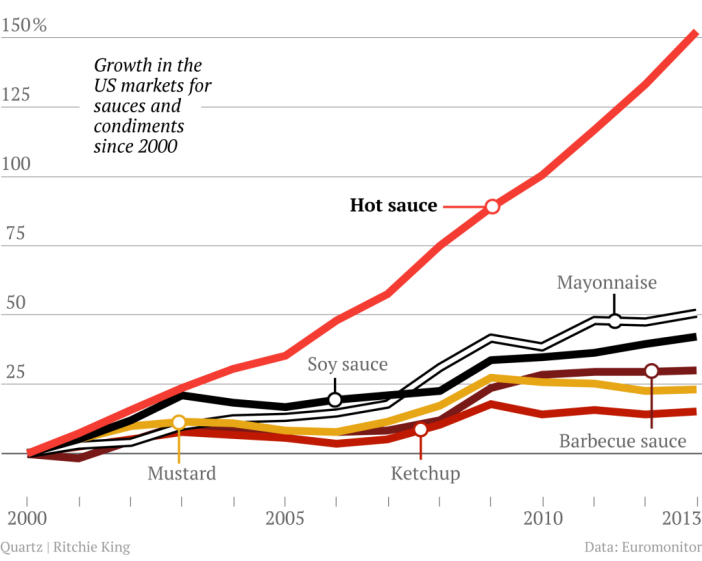
I cannot believe a month has already gone by! Looking back on my project, I’m feeling a mix of emotions – pride (for challenging myself and my skills), exhaustion (coming from my total overextension of my time and abilities in my extracurricular commitments), and curiosity (I’ve got a strong desire to learn more and continue testing my spice limits). If given the opportunity to do my project over again, I would have wanted to do more – more cooking, more posting, more research – it just simply felt like there weren’t enough hours in the day (but what else is new). Despite that, I am still as excited about this project as I was when the ideas first started storming last spring, and I’m leaving the month of January feeling excited about a chili-laden future.
I have two main takeaways from my independent study this month:
- I like spicy foods. I’m certainly not going to be eating whole habaneros just for kicks any time soon, but I’ve really learned to enjoy the burn. Things are still as spicy as ever, but the more I expose myself to chili, the more I am able to taste the other flavors in the dish. What was once a total meal-ruiner (hundreds of “I can’t eat this!”) is now a fun and welcome challenge. Feeling the burn is a fun way to control my body – I am in control, I know what I’m getting myself into, and I feel present. I like the glisten, I like to sit with it afterwards with the tingle on my tongue. My preferred level of spice is still around the second sauce (cayenne, 30,000 SHU), but I’m willing to test those limits because I can now confirm that my tongue will in fact, not fall off. I am now the proud owner of a fabulous hot sauce collection that I hope will continue to grow throughout my life.
- I should not be my own boss in the foreseeable future. For a girl that once considered herself a master of time management, this month often felt like it was slipping away from me. Not having imposing deadlines set by authority figures or the threat of exams has really made it difficult to prioritize my independent study project. It was certainly good practice, and is a skill I will continue to work on!
In all seriousness, this project has been a blast. I’m leaving January feeling proud of myself, the work that I have accomplished, and my excitement towards the future. I have learned a lot about how our body experiences spice, I have thought deeply about why spice persists and the power it holds over humans and our emotions, and I have instilled a love of chili within myself. All in all, I’d consider that a resounding success.
Dear reader, thank you for sticking with me! I appreciate your emails, texts, and comments as I went through this adventure. Hope to share some spicy food with you soon!





 Where capsaicin is found: Capsaicin is found mostly in the placental tissue and the white pith of the inner wall of the chili pepper. To a much lesser extent, capsaicin is found within the main flesh of the pepper (the pericarp). The seeds themselves do not produce any capsaicin – while the practice of “removing the seeds” does help decrease spice, that is because the placental tissue and pith are removed which contain the highest capsaicin concentration in the whole pepper. When people eat the whole pepper, you know they’re not
Where capsaicin is found: Capsaicin is found mostly in the placental tissue and the white pith of the inner wall of the chili pepper. To a much lesser extent, capsaicin is found within the main flesh of the pepper (the pericarp). The seeds themselves do not produce any capsaicin – while the practice of “removing the seeds” does help decrease spice, that is because the placental tissue and pith are removed which contain the highest capsaicin concentration in the whole pepper. When people eat the whole pepper, you know they’re not  n a pepper a specific SHU, an exact weight of dried pepper is dissolved in alcohol to extract the heat components, than mixed with sugar water in varying dilutions and given to a panel of five trained tasters. The process of dilution continues until at least three of the five tasters can no longer detect the heat in the sugar-water-capsaicin solution. As you are probably thinking, using humans to assign arbitrary units to anything seems incredibly subjective – and you’re right! Results for the same pepper vary widely in final SHU assigned depending on the laboratory performing the test, which explains why the sauces I’m using have a wide range of possible heat. The pungency of peppers within a species can also have a great amount of variation due to considerations such as climate, lineage, and soil conditions.
n a pepper a specific SHU, an exact weight of dried pepper is dissolved in alcohol to extract the heat components, than mixed with sugar water in varying dilutions and given to a panel of five trained tasters. The process of dilution continues until at least three of the five tasters can no longer detect the heat in the sugar-water-capsaicin solution. As you are probably thinking, using humans to assign arbitrary units to anything seems incredibly subjective – and you’re right! Results for the same pepper vary widely in final SHU assigned depending on the laboratory performing the test, which explains why the sauces I’m using have a wide range of possible heat. The pungency of peppers within a species can also have a great amount of variation due to considerations such as climate, lineage, and soil conditions.


